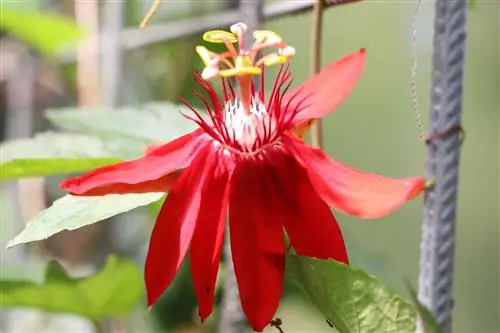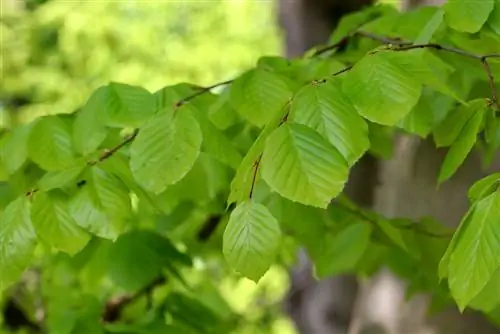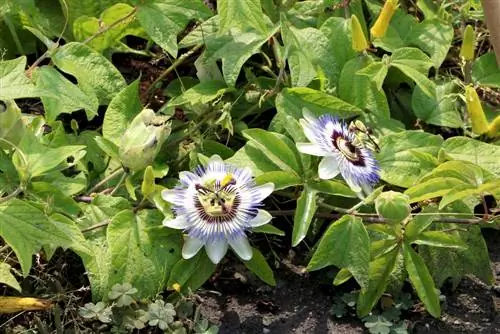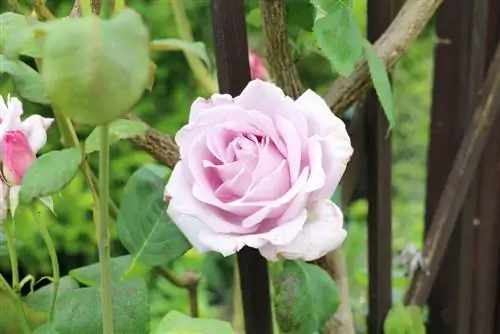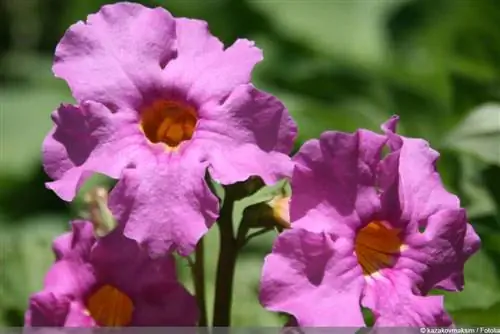- Author admin [email protected].
- Public 2023-12-17 03:39.
- Last modified 2025-06-01 06:48.
Passion flowers are known and loved primarily because of their enchanting, somewhat bizarre-looking flowers. When the thick, oval-shaped bud of the passion flower opens, the true splendor of the otherwise rather inconspicuous plant becomes visible: white or brightly colored petals enclose a thread-like, often very intensely colored halo.
With spiraling tendrils on its long, thin shoots, the passionflower clings to any available support to grow upwards. Some types of passion flowers easily grow to over six meters tall. Passiflora caerulea is usually cultivated as a houseplant because it blooms as a young plant and is much easier to care for than many of its more than 500 conspecifics. Some species of Passiflora are very flowery and produce their flowers from late spring to autumn.
Short profile
- botanical name: Passiflora
- belongs to the genus of passionflower family (Passifloraceae)
- perennial, herbaceous or woody plant
- mostly climbing plant
- very showy flowers
- dark green, stalked leaves of various shapes, often finger-shaped
- Growth height: up to over six meters
- Use: flower ornamental plant (climbing plant)
Species and occurrence
Most of the over 500 species of passion flowers come from tropical areas of South and Central America. About 20 species are also native to Australia. Passion flowers (Passiflora) usually grow as climbing plants on large trees or bushes. To do this, they form spiral-shaped tendrils in their leaf axils with which they can hold on. The blue passionflower is very popular as a houseplant.
- Passiflora alata: very striking, strong red flower with a bright halo, diameter 8-13 cm
- Passiflora aurantia (Golden/Orange Passionflower): Australia, orange filigree flower
- Passiflora caerulea (blue passionflower): most common type, white flower with light purple (blue) halo, flower size 6-9 cm
- Passiflora capsularis: completely white flower with a size of about 3-4 cm
- Passiflora citrina (lemon passionflower): filigree, yellow flower, flower diameter 3-5 cm
- Passiflora colinvauxii: white flowers with a purple base, 3-4 cm
- Passiflora incarnata: flower with striking white-purple striped secondary crown, 7-8 cm
- Passiflora ligularis (Andean region, Peru): white flower with purple halo, 6-7 cm
- Passiflora morifolia: completely white flower, violet aureole towards the base, 2-3 cm diameter
- Passiflora quadrangularis: purple flower with long threads, 11-13 cm diameter
- Passiflora racemosa: long, narrow, red petals, flower size 8-10 cm
- Passiflora violacea (purple passionflower): light to dark purple flowers
- Passiflora vitifolia (vine leaf): red flower with red aureole, up to 16 cm
Trees
Passion flowers of the subgenus Astrophea are not climbing plants, but grow as small trees. These include, among others:
- Passiflora lindeniana (only a few specimens left in Venezuela)
- Passiflora macrophylla (rare tree in Ecuador)
Crops
The edible fruits of some species are also available in our fruit shops. These include:
- Passiflora edulis: passion fruit
- Passiflora ligularis: Grenadilla (Granadilla)
Location
A passion flower prefers a very bright and warm location. A place where the plant receives direct sunlight for a few hours a day but is protected from the midday sun is best. In cool or dark locations, Passiflora produce no or very few flowers. Although passionflower is usually sold as a houseplant, it works just as well - if not better - as a pot or balcony plant. In a sheltered, full-sun location, it can spend the entire summer outdoors until the first frosts.
- Light requirements: sunny to partially shaded
- Temperature: warm
- also outdoors in summer (balcony or terrace)
- high humidity
Tip:
After getting used to it, the Passiflora caerulea can also tolerate full midday sun.
Floor
As a house and balcony plant, the passion flower needs a pot that is as voluminous as possible. In addition to good stability, clay pots also offer the advantage that they can somewhat buffer high water and nutrient contents. Passiflora has few demands on its substrate:
- well permeable to water
- easy
- a good mixture consists of clay, humus and sand
Pouring
During the main growing season between spring and autumn, passionflower needs a lot of water. You should water so much that the soil is always slightly moist but never wet. Excess water must always be removed from the saucer immediately, as the roots are sensitive to waterlogging. During the dormant phase in winter, watering is limited to a minimum and watered just enough so that the soil does not dry out completely.
Fertilize
Between March and the end of August, the passionflower is supplied with nutrients once a week with a universal flowering plant fertilizer according to instructions. In winter, fertilizing can be stopped completely in a cool place. When overwintering in the apartment, the passiflora is further fertilized with a quarter of the amount of fertilizer. Requirement: It is warm and bright in the room. If the passion flower sprouts vigorously again in spring, the normal fertilization rhythm (weekly) is continued.
Cutting
As a climbing or climbing plant, passiflora grows very quickly. Therefore, in addition to a trellis to hold on to, it needs occasional pruning. This means the plant always stays nice and bushy because it forms many side shoots and doesn't just grow upwards. Before putting it into winter quarters, it is a good idea to cut back the passionflower.
- Main shoot clearly recedes
- prune all side shoots except for five eyes
- remove all sick and dead shoots
Wintering
In summer, all types of passionflower can be treated equally. In winter, however, the plants have very different needs. For this reason, it is very important to know what type of Passiflora it is and what temperature group the plant belongs to.
1. Consistently warm temperatures
Many Passiflora species are native to tropical areas where temperatures are consistently high. They feel comfortable at around 20 degrees all year round and are sensitive to cold.
- Lemon passionflower (Passiflora citrina): minimum temperature 15 degrees
- Vine-leaved passionflower (Passiflora vitifolia): minimum temperature 15 degrees
- Passiflora colinvauxii: minimum temperature 15 degrees
2. Rest period cool, but frost-free
Most types of passionflower require a period of rest between October and March to prepare for the new growing season. You can easily overwinter them in a bright place at cool temperatures (5-10 degrees).
- Time: mid to late October
- Temperature: around 10 degrees
- A cool (frost-free), bright place in the winter garden or greenhouse is ideal
- alternatively all frost-proof, unheated rooms (basement, garage)
- A plant light is necessary in dark rooms
This group of passion flowers includes, among others:
- Passiflora alata: minimum temperature 10 degrees
- Golden/Orange Passionflower (Passiflora aurantia): Minimum temperature 1-5 degrees
- Passiflora capsularis: minimum temperature 5 degrees
- Passiflora ligularis: minimum temperature 5 degrees
- Passiflora morifolia: minimum temperature 10 degrees
- Passiflora racemosa: minimum temperature 10 degrees
- Purple passion flower (Passiflora violacea): minimum temperature about 5 degrees
Tip:
The warmer the plant is in winter, the more light it needs. At around 6-8 degrees, a moderately bright room is sufficient. In the warm, the passiflora forms long light shoots and turns yellow if it is too dark.
3. Frost-resistant species
North American species of passionflower and some other species can also tolerate temperatures down to -15 degrees. Passiflora incarnata even needs a cold period so that the seeds can sprout. However, passion flowers that overwinter outdoors should be planted in the ground so that their roots are better protected than in a pot. A thick layer of bark mulch or straw applied to the ground protects the underground parts of the plant. As a rule, the shoots of outdoor passionflowers die when there is frost and only the rhizomes survive. From spring onwards the plant will sprout again. In wine-growing regions where winters are mild, a passionflower can easily overwinter in the garden. Southern house walls that store heat are particularly suitable. Species that tolerate frost include:
- Passiflora affinis
- Passiflora caerulea (Blue passion flower)
- Passiflora incarnata
- Passiflora lutea (from northern USA)
- Passiflora tucumanensis
Diseases and pests
Passion flowers are not very susceptible to disease. In warm winter quarters, infestations with sucking pests can occasionally occur.
Conclusion
If you know which temperature group the passion flower belongs to, caring for it is basically very simple. A very bright location, a moist substrate and a little fertilizer during the vegetation phase are sufficient conditions to get the passiflora well through the summer. It also likes to stand outdoors on a balcony or terrace. In winter the individual species have to be treated very differently. Passionflowers that require constant warmth can be overwintered in heated rooms. However, the majority of passiflora prefer a dormant period in cool, frost-free temperatures. Some species can also spend the winter planted outdoors in mild locations.

